Herdsires: Selecting the right male(s)
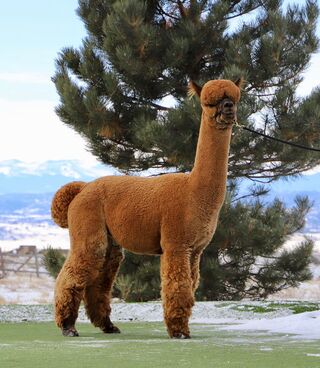
Herdsire
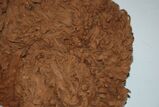 |
Herdsire's Fleece |
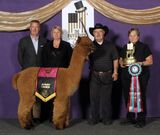 |
Herdsire Winning Awards |
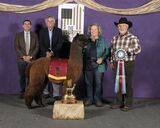 |
Offspring Winning |
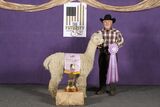 |
Offspring Winning |
Selecting Herdsires is easily one of the most rewarding aspects of breeding any type of livestock animal -- but it can also make or break an entire generation at your farm. Choosing the right herdsire can take your herd to the next level instantly, and choosing the wrong one can send you in a downward spiral very fast. Here are some things to consider before you start throwing your money at males.
Program Breeding Goal: What is your breeding goal? Color? Fineness? Staple Length? Less guard hair? Each one is not necessarily exclusive of another. If you do not have a definitive direction, decide where you are aiming to be. It may be breeding fine fibered blacks for the commercial fleece market; breeding for a specific color; breeding for the attractive dark brown alpacas, whatever...Different studs offer different strengths. Each female alpaca needs something different to improve the next generation. For fiber breeding goals remember that different fiber characteristics suit different markets and products. Your fiber breeding foals must synchronize with your product intentions for them to succeed. Whatever your breeding goal is, keep it in mind when you are selecting a stud. To maximize your return from the stud fee purchase/actual full purchase, you need to ensure the male is best suited for your female(s) and your breeding goal.
What is a Herdsire?: A Herdsire is a male alpaca that you keep primarily for producing offspring at your farm, and sometimes other breeders will pay a stud fee to have your hersire breed with their females. He is meant to produce many high quality cria's and expand without crossing bloodlines. A herdsire should be one of, if not the, best quality male you have on your farm. But keep in mind that when you are acquiring a herdsire you want to start with the highest quality one you can purchase. If you start with a low quality herdsire, you will need to continually find better quality to improve the actual quality of your herd. Start at the top, not the bottom.
Herdsire Selection Considerations: When you are selecting a herdsire you need to first make sure he has zero conformation faults. His legs must be straight and his bones full and thick. If you have a crooked legged herdsire, then you are most likely going to end up with a herd of crooked legged alpacas. Next, look for the quality and quantity of his fiber. Depending on your preference, the herdsire you pick will vary greatly here. You ideally want a male who will produce large amounts of fiber and produce the highest quality of fiber, having a male who can do both is pretty rare. For even more insight take a dive into that males bloodlines and see how much fiber is produced by each animal and the quality of that fleece each year, if available.
A Herdsire doesn't need to be a champion, but it is nice to have -- you also don't want to bet your farm on a young male just because he bannered, and not every male that banners will be considered a Herdsire, a fourth place animal can be just as good of a herdsire as the first place winner, it is a matter of if he has it or doesn't have it. That is the truth. You want to have as many potential suitors as you can to begin selecting from.
Many breeders across the world use the process of elimination in order to select the perfect herdsire for their herd. Starting with a group of males, breeders will eliminate them from the running as they do not meet the standards. Every breeder will have certain standards that those males will need to meet in order to be taken into consideration. Those males who do not make the cut will either be sold as performance animals or geldings, and sometimes may be sold as possible Herdsires for other breeders. Keep in mind that a male who doesn't make a breeder's Herdsire cut may make another breeder's Herdsire cut, and that can simply be because that male has what a breeder wants but the other breeder already has -- it is that simple. Any good breeder will not sell a Herdsire quality male that has any conformation issues to another breeder, but will sell it because that male no longer meets their standards but they know that said male can help improve someone else's program.
- Color: If You are breeding whites it is best to breed to a white that has previously thrown a lot of white progeny and or has the pedigree of a white powerhouse. Predicting color is tricky (color testing helps). The color in the background of the male is the least-best indicator of what he will throw in his progeny. Often matching a male alpaca up with certain colors will produce a specific color, but not always.
- Show Results: How they place at shows can also be very important. Has he gone to any shows? How did he compete against those particular males? Take a stash of ribbons with a grain of salt. Make sure they were at sanctioned shows and not from the local county fair. An award makes a statement about a certain place at a certain time competing against certain males. However, if there are a lot of ribbons on the backboard, you may want to take notice.
- Presence & Temperament: For us, this is important. We have grandkids, and therefore we like all of our animals to have mild temperaments at all times. No one wants to work with a crazy alpaca.
- Conformation: Under no exception (unless through a medical reason) should a male you are using in your program have any conformational faults. He should stand upright without a sloped neck. His neck and legs should be the same length, both of which are ¾ the length of the body. He should have “perfect” conformation.
- Fiber Traits: Micron and shear weight are generally seen to be the most important in huacaya, but these traits are contra-indicative - lower micron and higher shear weight do not necessarily correlate. Fineness carries a premium, and some breeding programs value fineness well ahead of density. If you are seeking extreme density in a higher micron, choose a stud from a farm that concentrates on dense alpacas. This is difficult to feel just by putting your hands on him. “Feeling dense” could mean that he has extremely coarse fleece…or it could mean he is really dense. The best way to find this out is to get a punch biopsy or a certified AOA judge evaluation. Consider uniformity (the percentage of the total fleece that is usable in top grade production). Uniformity changes considerably with age. Guard hair in the blanket is very undesirable because it will make itchy, scratchy alpaca clothing. But, guard hairs in the chest area are considered acceptable because this fleece is used in a different manner. Nevertheless, look for a male who maintains his uniformity with age.
- Crimp: Always a nice thing to have in breeding males, don’t you think? Crimpy fiber helps garments stay together when made into yarn
- Pedigree/Genetics: Check The Alpaca Owners Association (AOA) registry for the pedigree of the stud for any common ancestors he has with a said female and or your herd. Look at the colors and who they came from. Is this male anomaly or is he consistent with great alpacas in his background?
- Production History (if available)
Here are some Herdsire Selection tools we use, as well as other breeders:
- Line Crossings that have proven to cross well
- Show ResultsCertified Judges hands and eyes + your own hands and eyes
- Researching the offspring of each herdsire under consideration (for those males that are proven)
- Mentor's thoughts/opinions
- Taking into consideration the marketability of the offspring, which comes from the herdsire producing top quality offspring
You are making an important decision in choosing a stud. Take some time and effort to make the right one. Match the information you gain to you specific herd improvement need,
|